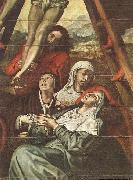| ID |
Image |
Oil Pantings, Sorted from A to Z |
Other Information |
| 62362 |
 |
Descent from the Cross |
320 x 191 cm (entire painting) Cathedral, Seville In Seville, the second third of the sixteenth century also witnessed the introduction of a style of painting that reflected the ascendancy of Raphael. In this center, the most important artist of the period were undoubtedly of Northern origin: the Dutchman Fernando Esturmio (Storm), and the Fleming Pedro de Campa?a (Kempeneer). The latter, the more gifted of the two, was born in Brussels in 1503. He was trained in Italy, but in 1537 he is known to have been employed in the Cathedral of Seville. Shortly before 1563 he returned to his native country. The style of this master includes elements derived from Michelangelo, but these are offset by original plastic qualities and a sense of drama. One of Campa?a's key works is the Descent from the Cross (1547) in Seville cathedral, a painting that anticipates the Baroque of Rubens and was much admired by other Spanish artists, particularly Murillo. Campa?a had a more amiable and genuinely Raphaelesque side, evident in the altarpiece of the Marshal's Chapel in Seville cathedral, which he was commissioned to paint in 1555. His progress toward the Baroque and his interest in the rendering of light are revealed in his admirable Adoration of the Magi, which was painted in 1557 |
| 43676 |
 |
Entombment of Christ |
Tempera on wood,
82 x 90 cm |
|